Today we (finally) get to talk about Intel Optane technology based on 3D XPoint. This is the most exciting announcement in the storage space thus far this year. The Intel Optane technology will occupy the space between RAM and NAND in terms of performance and endurance. The first implementations that will be publicly available are the PCIe devices either in AIC or U.2 2.5″ form factors. While these are a significant advancement for storage devices, where we are hearing the biggest buzz from Silicon Valley companies is in terms of extending RAM with a high capacity, lower cost, alternative. The first 3D XPoint device from the company will be the Intel Optane SSD DC4800X and is available starting today in the 375GB PCIe AIC form factor.
Intel Optane SSD DC P4800X Overview
Here is the summary slide from Intel on the new Optane SSD:
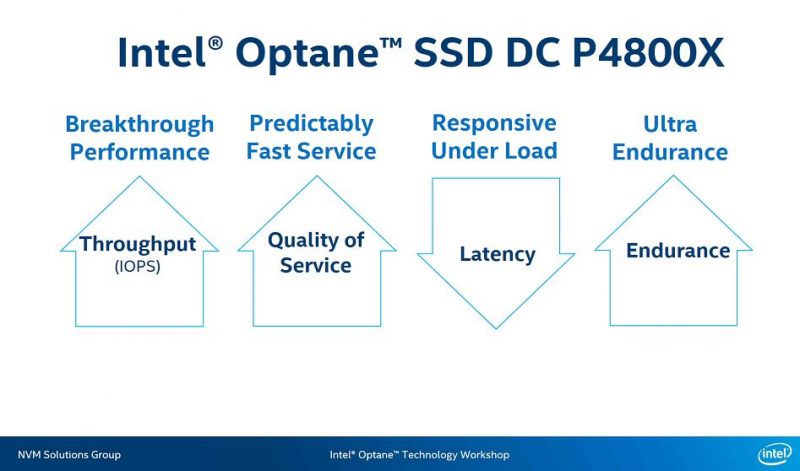
The key here is more IOPS, better QoS, lower latency and higher endurance. What is not to like right?
In terms of use cases, there are two main use cases for Optane. The first is to use the new drives as faster SSDs either as primary storage or as a cache. The alternative use case, and the more exciting, is to extend memory to a much larger footprint at a lower cost.
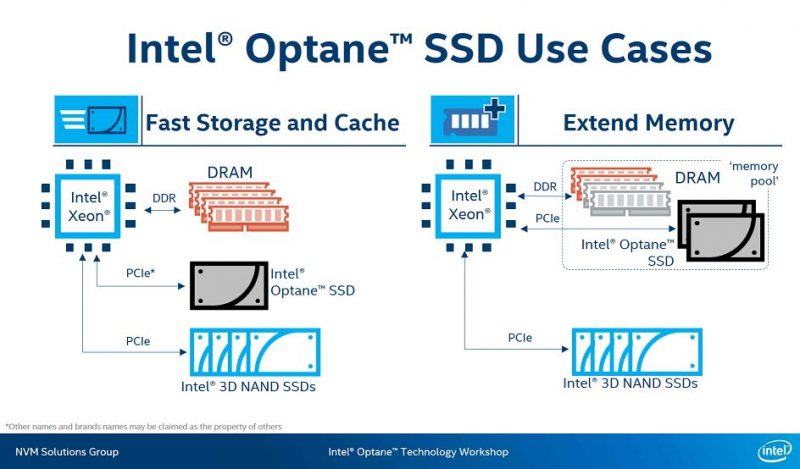
If you are not aware of why extending memory is a hot topic, here is a data point. We have seen some software solutions using NVMe SSDs as a larger RAM pool achieve up to 80% of full RAM write speeds yet at a tiny fraction of the overall system prices for 10TB+ of RAM. Optane promises an even lower latency version of storage that can be used for similar purposes. Many companies are extremely excited about the DRAM slot versions of Optane that will have access to a lower latency, higher bandwidth bus. The first iteration of Optane in a PCIe form factor are going to be constrained by the PCIe bus latency.
In terms of endurance, Optane is now the #1 drive for applications such as ZFS ZIL devices because it offers performance at endurance levels that are excellent. Intel is quoting 30+ DWPD endurance ratings for the Intel Optane series. This is a huge feature for Optane drives as they need to achieve high-levels of endurance to play in the memory tier.
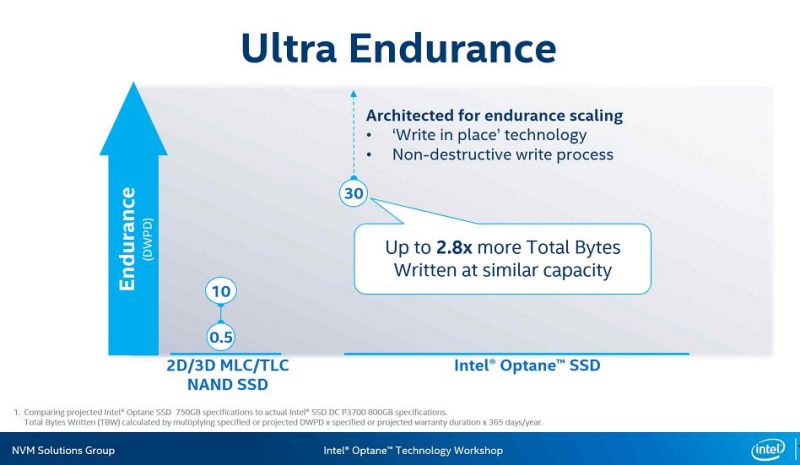
We are presenting this a bit out of order compared to the Intel presentation, but here is the overall slide on the now released Intel Optane SSD DC4800X series.
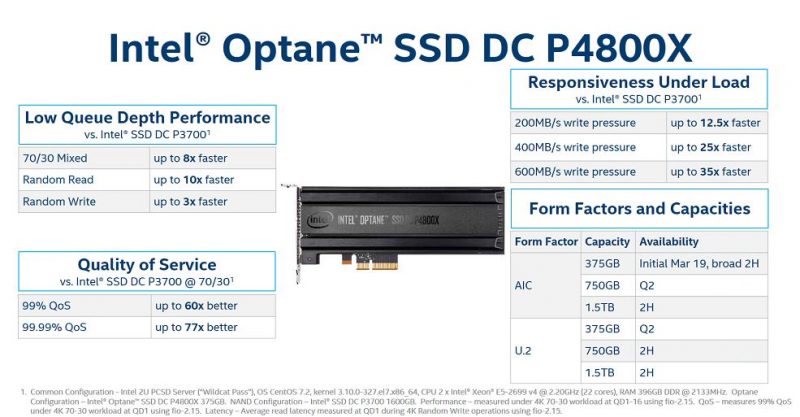
We are going to look at some Intel drill-down slides but the key tenets of Intel’s technology are there. Improved low QD performance and lower latency yield better QoS metrics.
The capacities will be 375GB, 750GB and 1.5TB with the AIC versions of the product launching first.
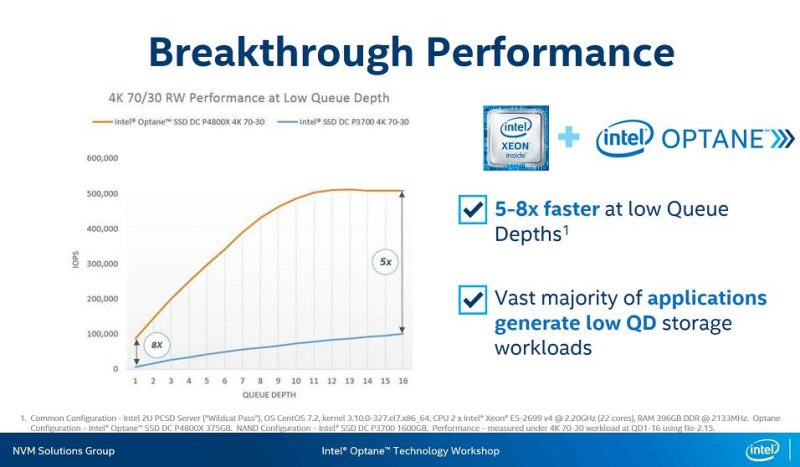
In the Intel specs, you are going to see a major shift in terms of how performance is measured, and for good reason. Modern NVMe SSDs can already saturate PCIe in sequential workloads. Intel needs to show next-generation of complexity storage metrics to ensure that the PCIe version of the product shows significant gains. At low queue depths, the Optane SSD can be up to 8x faster than NVMe NAND SSDs.
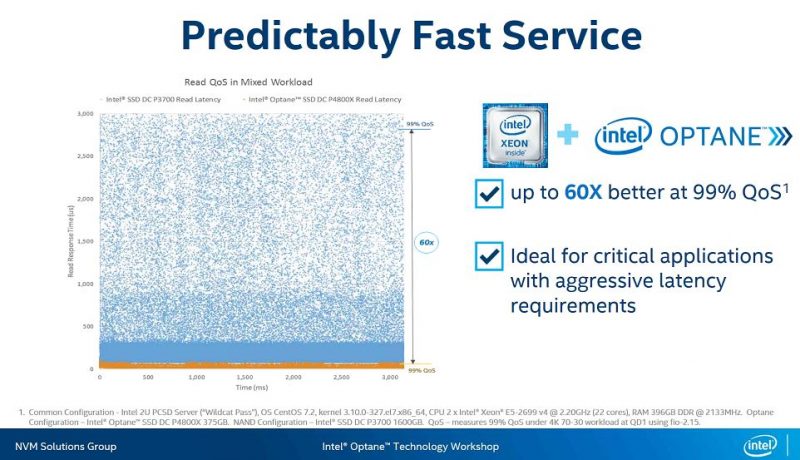
With lower latency operations, the Optane SSDs allow for tighter QoS and the ability to handle both read and write operations better than NAND SSDs. For example, here is how Intel is showing QD1 Read+Write latency. You will note, QD1 operations are the best for Optane and the worst for NAND SSDs.
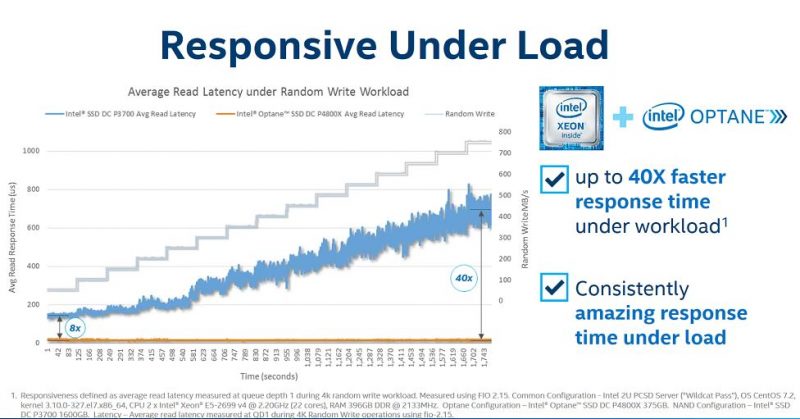
The chart is depicting what happens to read latency at QD1 as the amount of writes increases. The blue line is the Intel DC P3700 (still a gold standard in NAND SSDs) and the gold line is the DC P4800X. As the write load increases, the read latency stays constant on the Optane and increases on the DC P3700.
Intel Optane SSD DC P4800X Performance
Intel has a number of performance use cases. For example, it showed a MySQL use case. MySQL (and forks) are extremely popular database applications, especially in web infrastructure.
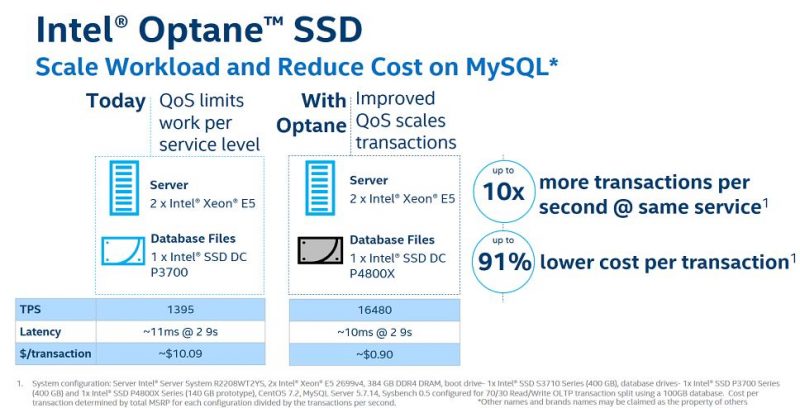
The key here is that the machine was able to handle about 10x more transactions per second at 10ms latency.
Likewise, it looked at the time to complete 1M transactions on a SATA SSD (S3500) RAID array versus the same array with an Intel DC P4800X SSD being used as a cache device. The time taken was reduced by over 80%.
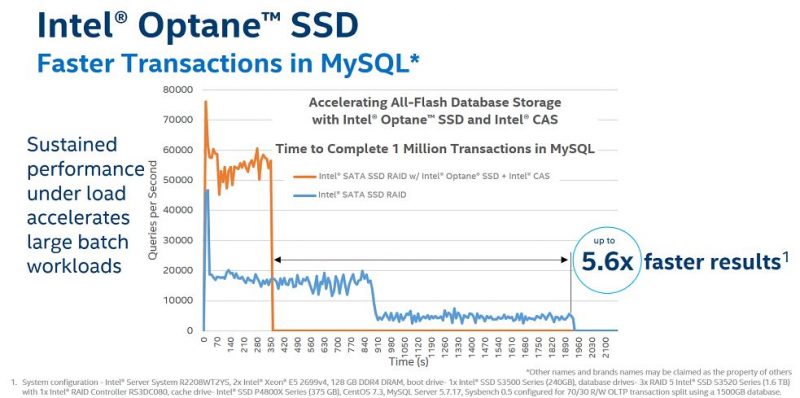
Intel did also produce a small Ceph BlueStore Kraken cluster (5-nodes) benchmark results swapping the Journal/ Metadata drive layer with Optane versus a PCIe SSD.
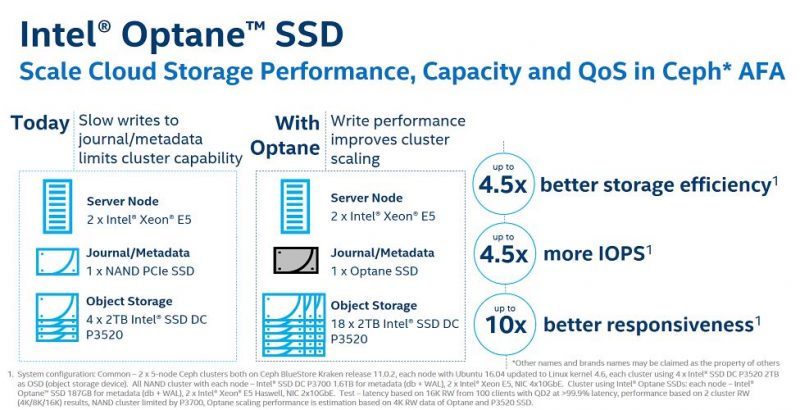
They key here is that the Intel DC P4800X allows more low-cost PCIe SSDs to be serviced by each node with better performance.
Extending Memory Options
Intel Memory Drive Technology is software Intel is going to provide to handle using Optane to extend memory. It boots before the OS and allows the system’s OS to have a larger memory pool. It handles data locality challenges to minimize NUMA performance impacts.
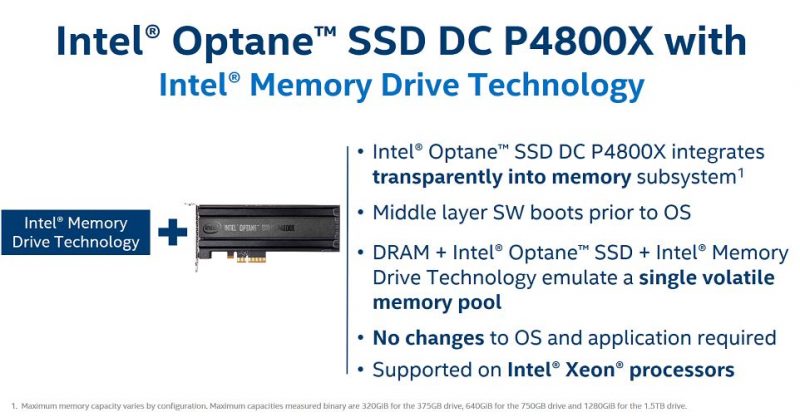
The Intel Memory Drive Technology system RAM to be increased by adding Intel Optane SSDs, and eventually DIMM sticks.
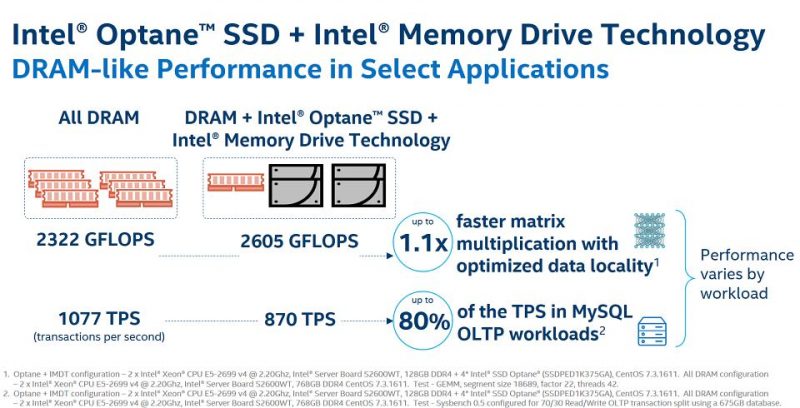
One of the major benefits is that you can also get higher memory capacities using fewer CPUs. For example, a dual socket Intel Xeon E5 system can have more effective memory than a quad Intel Xeon E7 system, saving an enormous amount of system cost.
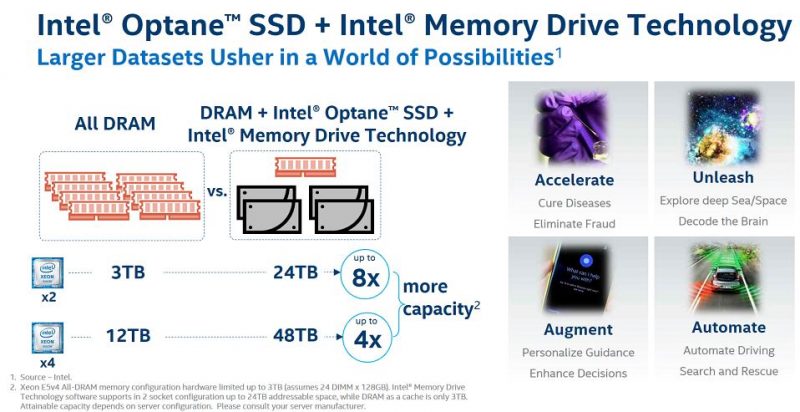
The above view is why there are so many companies interested by this. Further, if you think of implications for machine learning, being able to access larger local datasets in memory is a huge advantage.
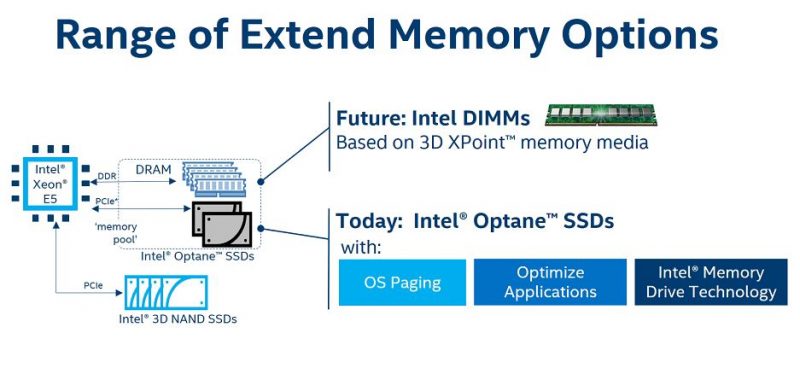
While PCIe SSDs are great, they are severely limited by the PCIe 3.0 bus in terms of latency and overall bandwidth. What we will see in the not-too-distant future is the DIMM-based Optane. There are many companies queueing for that version of Optane.
Final Words
This is a major release for the year, but it is also just the beginning. Intel has its ecosystem pushing the new technology. For example, VMware vSAN has some workloads where it is getting a 2x write speed improvement. The list of vendors supporting this from a hardware perspective is huge. Further, we are on the verge of seeing startups with software and appliances for big data analytics, in-memory applications and a myriad of other applications launch. Intel was also quick to point out that cloud providers such as Amazon, Microsoft and Google can charge significantly more for Optane QoS versus traditional NAND QoS as they already charge based on storage performance.

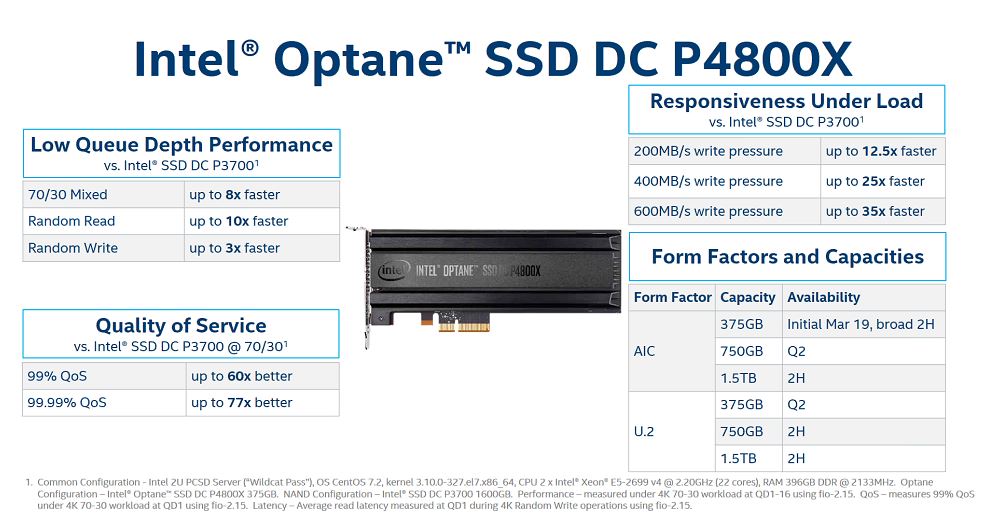

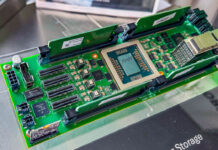
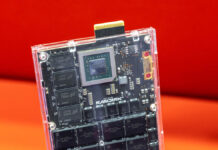
hey @patrick have you been able to get your hands on one of these yet? I am super curious when they will actually be shipping?
-tim